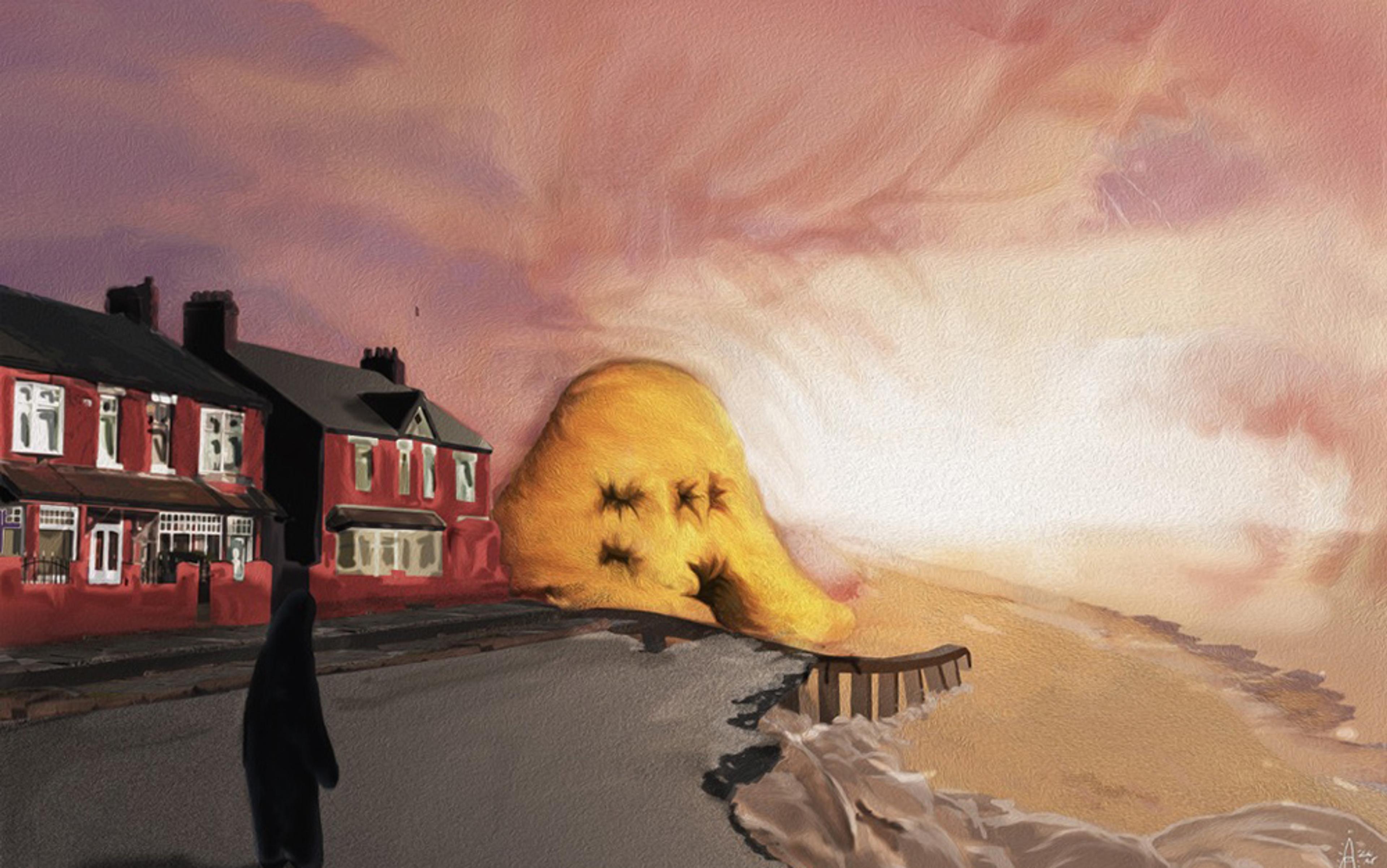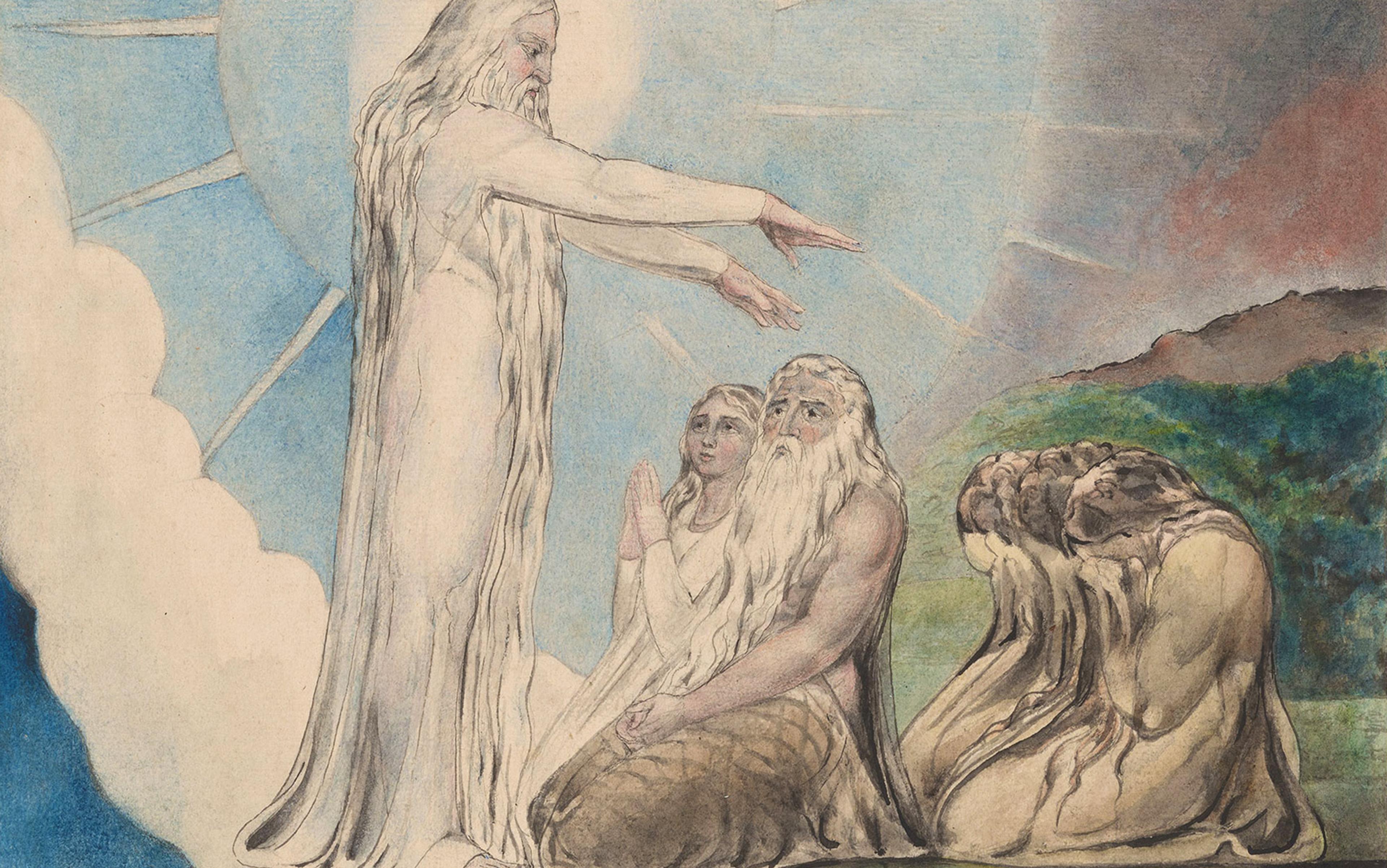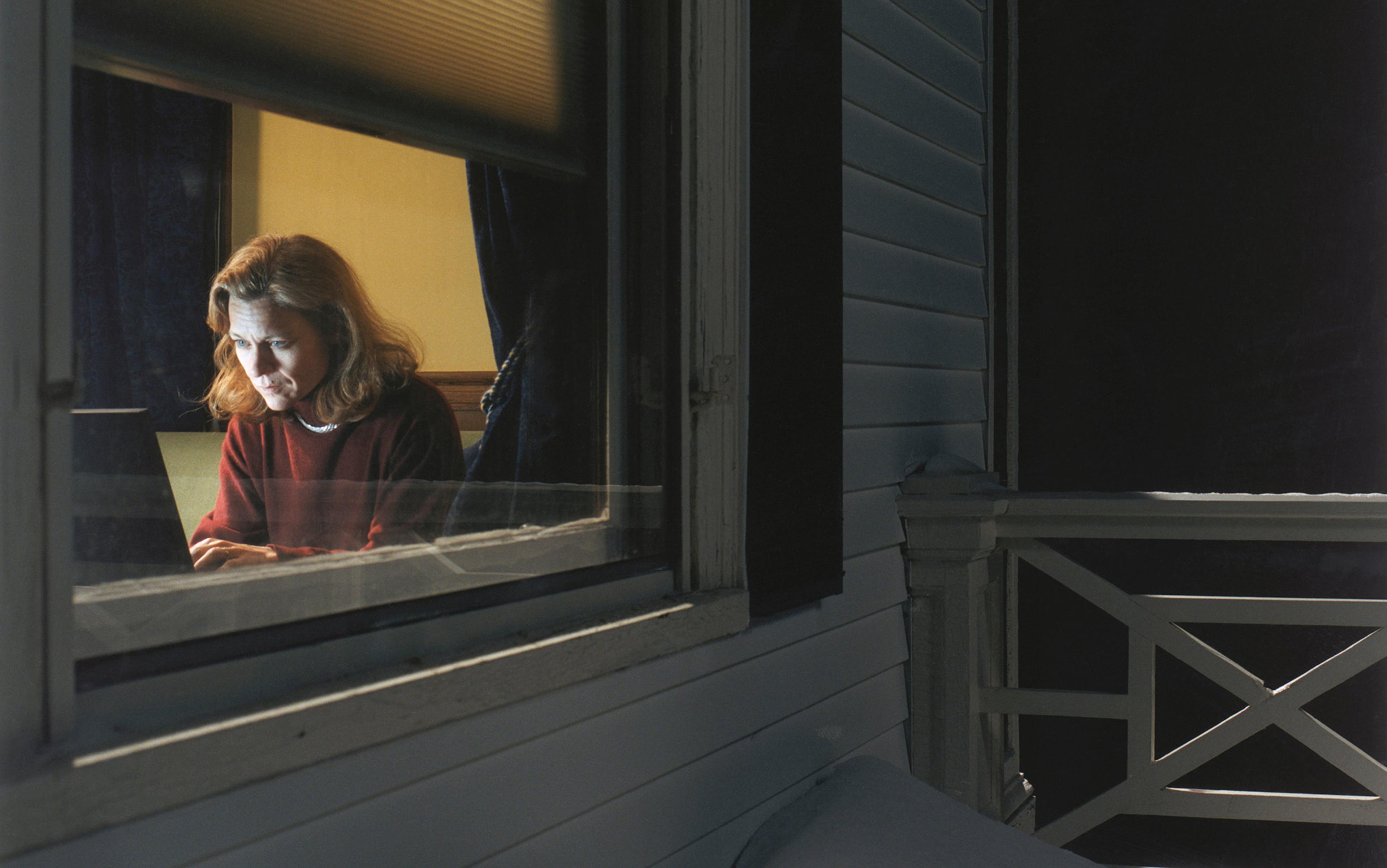In the Old Testament, Jacob, on the run for his life from the twin brother he betrayed, beds down for the night in the wilderness and there dreams of a ladder stretching between heaven and Earth, of angels ascending and descending, and of God assuring him of an auspicious future. With his head on a pillow of stone – symbolic of matter in its densest form – Jacob dreams of a structure linking the material and ethereal worlds. Jacob’s ladder is a story about an archetypal passageway between a rock and a soft place: between earthly troubles and sacred transcendence; waking and dreaming; consciousness and the unconscious.
From a sleep science perspective, Jacob’s ladder might represent the structure of REM sleep – a neural network linking the upper and lower regions of the brain. And the movement of angels could symbolise the process of dreaming, an ongoing dialogue between the waking world and the world of dreams. REM sleep and dreams represent two divergent takes on the same process: one is physiological; the other, phenomenological. One occurs in the body and brain, the other in the mind. To fully appreciate REM sleep and dreaming, our understanding of each must be triangulated into a new higher-order concept I will call REM/dreaming (I will continue to use the terms REM sleep and dreaming separately when referring to their distinct features). Part-waking and part-sleep, REM/dreaming is a hybrid state of consciousness, a borderland between the material and ethereal worlds, between the body and mind.
Research about REM/dreaming began in the mid-1950s and accelerated sharply with advances in neuroimaging. We now know that, independently of sleep – that is, of non-REM sleep – REM/dreaming plays an essential role in learning and memory, mood and immunity, as well as in creativity and artistic expression. Just as important, REM/dreaming stretches, expands and reshapes our very consciousness. From Morpheus, the Greek god of dreams, REM/dreaming effectively morphs our fundamental sense of self.
From a hard-nosed neuroscientific perspective, the subjective dream is merely an incidental, meaningless side-effect of REM sleep. It’s just a dream. The phenomenological study of dreams, however, which dates back millennia, has yielded a vast and intriguing literature of psychological, cultural and mythological observations. What might an integration of the science and subjectivity of REM sleep and dreaming reveal?
The body and mind go their separate ways during REM/dreaming. In essence, upper cortical executive functions become disengaged from lower limbic somatic functions. The body gets a break from the supervision of the authoritative, waking ego-driven mind, and the mind is liberated from the physical constraints of occupying a body. From the perspective of the mind, REM/dreaming is an out-of-body experience. From the perspective of the body, it’s an out-of-mind experience.
When the mind is away, the body gets wild, disorderly, even randy. REM sleep is characterised by autonomic nervous system ‘storms’ – powerful waves of somatic dysregulation of EEG, cardiovascular activity, respiration, blood oxygen and body temperature. Our voluntary muscles go offline, imposing a kind of neurological bondage on the body, which, independently of dream narratives, becomes sexually aroused. This seeming dysregulation can actually be a process of re-regulation that restores the body to its original factory settings by shaking off tension accrued under the watch of the waking mind. More specifically, REM sleep helps to regulate circadian rhythms, body temperature, hormones, metabolism and immunity.
The mind seems to grow fidgety and uncomfortable cooped up in a body 24/7. Mentally, dreaming is like taking off a pair of tight shoes at the end of the day: the liberated mind is no longer constrained by somatic sensory and motor processes. Reminiscent of common notions about the soul leaving the body in sleep, dreaming unfetters the mind from the world of matter; and, having vacated the body, consciousness is free to pandiculate, ponder and play. The dreaming mind stretches, yawns and reawakens in a strangely familiar place where it can time travel, dialogue with demons, get trapped in a mundane loop of doing dinner dishes or soar with angels. With Jacob’s ladder in place, the sky is literally the limit.
Since the discovery of key brain neurotransmitters at work in the digestive tract, it’s become normal to speak of the gut as a second brain. Digestion, after all, is a process requiring intelligent decision-making about whether to assimilate or excrete what a body has consumed. But if the gut functions as a second brain during digestion, then the brain is a second gut during REM/dreaming. Dream digestion sifts through short-term memories of recent waking experiences to determine what will be released and forgotten, versus what will be assimilated into existing stable memory networks to become part of who we are. In the process, negative emotions are downregulated while psychologically nourishing experiences are symbolically integrated into our sense of self. As suggested earlier, our very consciousness is morphed in REM/dreaming. One of my favourite psychotherapy cartoons depicts a therapist telling a patient to ‘have two dreams and call me in the morning’. Today, research suggests that dreaming functions as an endogenous form of psychotherapy.
Dreaming can be personal or transpersonal, revealing the world behind my world, or the world behind the world
One of the most critical overlooked functions of REM/dreaming is its mediation of sleep. Sigmund Freud saw dreams as the royal road to the unconscious. But dreams are, more accurately, the royal road to sleep. REM/dreaming is the bridge to and from sleep. Healthy sleep normally begins with, incorporates and then finishes with various dream states. We enter sleep through a brief hypnagogic dream characterised by rapid firing kaleidoscopic images – a swirl of faces and geometric patterns, as well as strange sounds, and that familiar sensation of falling. Narrative-driven REM/dream cycles then weave their way through the night, culminating in the morning in hypnopompic, groggy REM/dreams that segue us back to waking. The ability to shift from ordinary waking into dreamy states of consciousness is the key to the gates of sleep.
In his first book of alternative medicine, The Natural Mind (1972), Andrew Weil argued that humans have an innate need to expand consciousness, which if not met naturally will increase our chances of relying on substances and drugs to do so. Dreaming naturally expands consciousness. ‘What dreaming does,’ wrote Carlos Castaneda, ‘is give us the fluidity to enter into other worlds by destroying our sense of knowing this world.’ REM/dreaming is a way of perceiving that reveals the dreamscape – what the mythologist Michael J Meade called ‘the world behind the world’. In contrast to the intention-driven looking of ordinary waking consciousness, dreaming is a gentle, receptive way of seeing. Depending on the depth of our vision, dreaming can be personal or transpersonal, revealing the world behind my world, or the world behind the world.
Such revelations are not often pretty. Dreaming opens us to other worlds by destroying our sense of knowing this world – a process most evident around dark, nightmarish dreams. If ordinary REM/dreams digest and assimilate waking events into who we are, then dark dreams accommodate life’s most challenging experiences by changing our sense of the world and our place in it. If we let it, dreaming gradually erodes wake centrism – that waking consciousness to which Westerners in particular are inordinately attached. You might think of wake centrism as a pre-Copernican-like worldview that presumes waking to be the centre of the universe of consciousness, while relegating sleeping and dreaming to secondary, subservient positions. It is a matrix, a cultural simulation evolved to support adaptation, yet it inadvertently limits our awareness. Wake centrism is a subtle, consensual, sticky and addictive over-reliance on ordinary ways of perceiving that interfere with our direct personal experience of dreaming. To paraphrase the 16th-century British clergyman Robert Bolton, it is not merely an idea the mind possesses, but an idea that possesses the mind. Wake centrism is a flat-world consciousness. It warns us to stay away from the edges, to refrain from dialoguing with dreams and the unconscious.
Most dreams are expressions of the personal unconscious, and involve stories about identity, aspiration, neurosis, love and loss. Such personal dreams are like funhouse mirrors that reflect caricaturistic images of our waking lives. But when engaged more deeply, these mirrors morph into doorways that draw us into the looking glass. We are not in Kansas anymore. Here we can wander even further out of our ordinary minds into the collective unconscious, the place of transpersonal dreams. In contrast to classical Freudian approaches that assume all dreaming to be personal and subordinate to waking, Jungian or archetypal approaches are more aligned with dream cultures such as the Aboriginal peoples of Australia and the Achuar in the Amazon who view dreaming as a superordinate state of consciousness.
Most dreams have varying degrees of both personal and transpersonal features. Transpersonal features, however, are more likely to break the frame of wake centrism and open us to mysterious realms. In the rarefied atmosphere of the dreamscape, the mind is more curious than intentional, more empathic than judgmental, and more present than in waking. Not surprisingly, dreaming has long been recognised as a fount of creativity. Dreams have been instrumental in the development of Albert Einstein’s theory of relativity, Francis Crick’s structure of DNA, and Elias Howe’s sewing machine. The Beatles song ‘Yesterday’ (1965) came to Paul McCartney in a dream. August Kekulé might have discovered the circular structure of benzene in a dream of ouroboros – a snake devouring its own tail. And Larry Page’s original algorithm for Google’s web searches was dream-inspired.
Dreams are not simply stories, mental movies or mirrors of miscellaneous events. Irrespective of our beliefs about them, we experience our dreams as meaningful. And whether recalled or not, dreams impact our body and mind much like waking experiences do. Even if upon awakening we dismiss them as ‘just a dream’, they will have left a mark. Opening to dreaming doesn’t require believing that dreams are supernatural, only that they are meaningful.
But the depth of their meaningfulness can draw us into the supernatural. Carl Jung used the term ‘big dreams’ to describe rare, extremely vivid dreams that have a lasting impact on consciousness. Prominent examples include Zhuang Zhou’s classic butterfly dream (where he dreams he is a butterfly, and is unsure if he is a butterfly dreaming he is himself), common dreams of visits from deceased loved ones and, of course, Jacob’s ladder. Such unforgettable dreams have played crucial roles in the evolution of major religious traditions, concepts of demonism, prophecy, healing and spiritual practices throughout history. Not surprisingly, dreaming is often referred to as the language of God.
Today, there is indisputable scientific evidence, corroborated by anecdotal reports from clinicians, to indicate that we are in the midst of a silent epidemic of REM/dream loss that leaves us as least as dream-deprived as we are sleep-deprived, since so many lifestyle and medical factors suppress, damage or otherwise interfere with REM/dreaming. Alcohol is a common culprit. Consumed near bedtime, it can promote the onset of sleep, but it typically disrupts later sleep and REM/dreaming. Depending on dose and timing, alcohol can affect the start of REM/dreaming as well. Even a single drink taken as a nightcap can adversely impact REM/ dreaming. One can imagine how this plays out, when about 30 per cent of Americans routinely have a glass of wine with dinner, 20 per cent consume about two glasses, and the top 10 per cent of American drinkers, about 25 million adults, have more than 10 drinks per day.
Other substances frequently used as sleep aids, such as CBD (cannabidiol) and THC (tetrahydrocannabinol) are known, when used long-term, to impair sleep quality and disrupt REM/dreaming. Estimates of cannabis use in the United States vary widely but there is consensus that it has been increasing as a result of decriminalisation and medicalisation. The National Survey on Drug Use and Health (2019) reported that 35 million people aged 12 or older had used marijuana in the past month. REM/dream disruption is also a common side-effect of many widely used prescription and over-the-counter medications including opioids, antihistamines and anticholinergics. Given the role that REM/dreaming plays in supporting healthy mood, it’s ironic that nearly all prescription antidepressants and anti-anxiety agents, as well as certain hypnotics routinely prescribed as sleeping pills, interfere with REM/dreaming. And reliance on these drugs continues to increase in the US.
Because most so-called sleep disorders are also REM/dream disorders, much of what we consider sleep loss is also REM/dream loss. Millions of Americans who suffer from insomnia and obstructive sleep apnoea also suffer from compromised REM/dreaming.
In lieu of aspiring up dream ladders, we’re encouraged to climb social and corporate ladders
Yet, as Hamlet’s ‘to sleep, perchance to dream’ soliloquy implies, REM/dream loss is also rooted in a pernicious fear of dreams – especially bad dreams and nightmares. The psychologist James Hillman described this fear of and resistance to dreaming in terms of the common bedtime rituals we use to avert it:
we need incantations to summon Hypnos or Hermes to help us drop off to sleep, a ritual of prayer, toothbrushing and teddy bear, of masturbation, food cramming, and the late show, of night cap and sleeping pill. The basic bedtime story of our culture is that to sleep is to dream and to dream is to enter the House of the Lord of the Dead, where our complexes lie in wait. We do not go gentle into that good night.
Anxiety-provoking dreams and nightmares can also discourage us from returning to sleep after middle-of-the-night awakenings, further increasing dream loss, since if you can’t sleep, you can’t dream. Moreover, recent evidence suggests that most middle-of-the-night insomnia, conceptualised as ‘wake after sleep onset’ (WASO), is triggered by the advent of REM/dreaming. Ultimately, the epidemic of REM/dream loss is underpinned by a neglectful, wake-centric posture on the part of the public as well as health professionals. It’s telling that one of the most common uses of the term dream, as in ‘the American dream’, reduces it to a house. It collapses the ethereal into the material, pitching Jacob’s ladder on its side. In lieu of aspiring up dream ladders, we’re encouraged to climb social and corporate ladders, which run sideways and keep us tethered to the material world.
Modern Western medicine has forgotten its roots in Greek Asklepian practices, which viewed dreamwork as an effective intervention. Today, most physicians ignore the critical role that REM sleep plays in our general, psychiatric and sleep health. Sleep medicine specialists do attend to specific, less common, REM sleep disorders, but not to the impact of widespread dream loss or the key role of dreaming in insomnia. Because sleep medicine subsumes REM sleep under the general rubric of sleep, it obscures the fact that much of what we consider sleep loss is actually dream loss.
Although it’s impossible to prove a negative, sleep specialists generally presume that dreams are meaningless, and passively convey this to their patients and the public. Reducing subjective dreaming to epiphenomena of REM sleep discounts our personal experience. Although the brain does mediate REM sleep, it doesn’t dream. We do.
Perhaps most baffling professionally is the fact that psychotherapists have been losing interest in dreaming over recent decades. This is especially disconcerting among psychotherapists who treat sleep disorders and psychiatrists, who now receive little or no training in dreamwork. Not surprisingly, psychotherapists who attend to their own dreams are more likely to initiate dreamwork with their patients.
Given that substances, medications and sleep disorders have a clear deleterious impact on REM/dreaming, it is striking that the epidemic of REM/dream loss is a silent one. This very silence is characteristic of our relationship with the unconscious. If dreaming is a dialogue with the unconscious, then we are not on good speaking terms with it. We are a morphephobic culture, fearful of our dreams, of our unconscious, of the unconscious. The Western world has a long history of discouraging trust in the unconscious by presuming it to be irrational, selfish, aggressive, even evil. The phrase beat the devil out of, for example, originated in Christian superstitions that children were born with demonic inclinations. More recent Freudian notions defined the core of the human unconscious as ‘das es’, German for ‘the it’. Later sanitised by American psychiatry as ‘the id’, it remained a repository of selfish and aggressive impulses that needed to be reined in. This dark model of the human psyche has dominated Western thought for many decades.
In his book Humankind (2019), a recent evidence-based exploration of innate human proclivities, the historian Rutger Bregman challenges our mistrust of the unconscious. He debunks common cynical myths that humans are inherently nasty and selfish, offering a more accurate and radical portrayal of human nature that suggests that most people are good – ‘friendly, peaceful, and healthy’. Comforting as this might be, the question of whether we can trust the unconscious remains a deeply personal one. We must answer it for and about ourselves if we are to open our lives to REM/dreaming.
Health professionals and psychotherapists, and sleep medicine specialists in particular, could support rather than impede our addressing this important question by acknowledging the extent and seriousness of REM/dream loss. On a practical level, it would be prudent for them to establish a new diagnostic designation for REM/dream loss, thereby opening up avenues for treatment, encouraging further research, and the support needed for public health education.
Not surprisingly, REM/dream loss is associated with a range of mental and physical health concerns, including compromised immunity, increased inflammation, child and adolescent obesity, and increased sensitivity to pain. Damaged REM/dreaming is also characteristic of Alzheimer’s disease, dementia and REM sleep behaviour disorder (RBD), which dramatically increases the risk of developing Parkinson’s and other neurological diseases. Recent research has found that compromised REM/dreaming is also linked to increased mortality. Because REM/dreaming supports mood regulation, its disruption increases the risk for clinical depression. The classical psychoanalytic view of depression as a loss of one’s dreams appears to have a literal underpinning.
Dreaming is a place, a state of consciousness, somewhere we can, with practice, choose to visit
In fact, the sleep and dream architecture of most depressed individuals looks much like that observed in research subjects selectively deprived of REM sleep. Whereas in normal REM/dreaming the mind and body take time apart, the brains of depressed individuals exhibit increased executive function, which suggests that the waking mind or ego is still present and running the show. Psychologically, this might reflect a kind of vigilance symptomatic of wake centrism. But it could also impede normal self-regulation of REM/dreaming and disrupt the psychological assimilation of challenging experiences. From a REM/dream standpoint, depression is a form of emotional constipation. Not surprisingly, the dreams of depressed individuals are less fantastic and emotional, more passive, impoverished, mundane and difficult to recall.
Our relationship with REM/dreaming is about our relationship with that ethereal soft place: the dreamscape. Dreaming is a place, a state of consciousness, a somewhere that we can, with practice, choose to visit and hang out in. We might begin by righting Jacob’s ladder and engaging in dreamwork. The body, mind and spirit want and need to dream. We needn’t push the river, but we do need to un-dam it. But first, to optimise REM sleep, we must optimise sleep.
Because the brain prioritises sleep over REM sleep, good sleep is a prerequisite for healthy REM/dreaming. Although there’s an abundance of valuable sleep health guidance available, most of it is rooted in wake centrism. In telling us how to think and behave in waking life to improve our sleep lives, much of this guidance effectively tries to leverage waking to access sleep and so fails to direct us to the actual bridge from waking to sleep. More specifically, it fails to recognise the need to transcend waking by surrendering to dreaming.
When we remember that REM/dreams are the natural bridge to sleep, we realise that to sleep well we must also dream well. Given that alcohol, cannabis, as well as many psychiatric and other medications used for sleep, are ineffective in the long-term and also compromise REM/dreaming, it is essential to consider alternatives. The emerging field of integrative mental health recommends evidence-based natural alternatives that are much kinder to dreamers. Additionally, there is a wide variety of oneirogens – REM/dream-enhancing botanicals, nutraceuticals and drugs available over the counter. Even melatonin, customarily used to support sleep and regulate circadian rhythms, is a safe oneirogen.
Psychedelics, too, are potent oneirogens. Lee Adams, a dream researcher and champion of lucid dreaming, summarises this perspective in ‘Are Dreams the Original Psychedelic?’ (2009), reminding us that our pineal glands and lungs produce psychedelic substances during REM sleep that contribute to a sense of dissociation or transcendence. This speaks to me since my personal interest in psychology and dreaming was galvanised by adolescent experiences with psychedelics. Like big dreams, psychedelics expand consciousness beyond the matrix of wake centrism to reveal the world behind the world. It is my hope that the recent resurgence of clinical and spiritual research in psychedelics surveyed, for example, by Michael Pollan in How to Change Your Mind (2018), could help restore our regard for REM/dreaming.
I’m using the term ‘dreamwork’ to refer to the practice of habitually engaging with dreams – our own and those of others. Dreamwork is not about work in the ordinary sense of the word. It’s more about allowing the dream to work us. It involves practices that support recall, journaling, sharing and interpretation, as well as strategies for managing dark dreams. For those who rarely or never remember dreams, setting an intention to do so is a useful first step. We quickly find the unconscious is ready and willing to dialogue. And we enter this dialogue by lingering momentarily in halls of morning grogginess. Derived from the English rum drink, grog, the term ‘groggy’ suggests that waking up is about sobering up. Because we’re still partially asleep and dreaming, this wake-centric attitude quickly ushers us out of the dreamscape. Lingering in grogginess – which is an exquisite hybrid state of sleep, dreams and waking – keeps us at the edges of the dreamscape where we will, with patience, eventually begin to observe dream images.
Once we do, even if only in glimpses, it’s helpful to carry our observations to the waking world by journaling. We can do so orally with someone close by who is respectful of dreams, and/or with written word or drawn image. Journaling is not about translating the dream into the waking world terminology, but about learning the dialect of dreaming. It is about better understanding the culture of the dreamscape.
Rather than allowing our dreams to stretch and expand our sense of self, we’re inclined to downsize and sanitise them, squeezing them into familiar wake-centric frameworks. We are seduced by dream dictionaries that offer quick and clever impersonal interpretations, and by dream experts who likewise try to shrink dreams to fit into a wide range of objectified clinical frameworks. These approaches share a spiritually subversive, wake-centric and materialistic foundation. In contrast to the Judeo-Christian concept as it is above, so is it below, they are founded on the flipped notion of as it is below, so is it above. Working on the presumption that ordinary waking life is the ultimate reference for determining the meaning of dreams, they proffer canned interpretations in lieu of fresh experiences. Such popular approaches obscure the critical process of relating to dreams as organic, intelligent and personally meaningful experiences.
Dreams are like fish: we can better understand them by learning to swim
Viewing dreams with waking-world eyes is like surveying the glorious night sky through sunglasses. Dreamwork calls upon us to practise novel ways of perceiving and relating to mystery. It requires cultivating comfort with perplexity, ambiguity and confusion. ‘I ain’t afraid of confusion,’ sang Bob Dylan, ‘no matter how thick.’ Dreamwork calls for approaching dreams with a beginner’s mind – not prematurely dousing them with knowledge. Despite his extensive experience in dreamwork, Carl Jung advised: ‘One would do well to treat every dream as though it were a totally unknown object.’ Dreams are like fish. Rather than pulling them into the dry world of waking for analysis, we can better understand them by learning to swim. Infants, of course, seem to have an instinct about holding their breath under water. Likewise, I believe we all have an instinct about the dreamwork. Dreamwork is an instinctual skill. It is the same skill with which we approach story in literature, film, poetry, music, dance and art.
Ultimately, dreamwork is less about any clever analysis of dream narratives, and more about willingness to witness and experience the dream. As interesting as interpreting particular dreams might be, even more important is simply knowing that dreaming is meaningful. This understanding can help us be more receptive to allowing dreams to work us, to expand our sense of the world and ourselves.
Jacob’s ladder appeared at a moment when Jacob was in serious trouble, since the brother he’d betrayed now wanted him dead. Jacob had done nothing special to deserve his big dream. He hadn’t been fasting, doing karma yoga, or participating in a mindfulness retreat. He was an ordinary guy in a troubled time – and dreams, especially big dreams, are a natural and effective way of negotiating troubled times. And we live in troubled times. In this great era of globalisation – of global warming, an economics of greed, and pandemics – our dreams readily reflect the expanse of the collective unconscious, of shared hopes and dark forebodings. Indeed, we see reports of increased dreams and nightmares in these times.
Rather than push those nightmares and phantoms aside, we might engage in what Jung called ‘shadow work’ – a process of dialoguing with frightening dream images. This can be done while dreaming lucidly or afterward by reliving the dream. The essence of shadow work involves finding diamonds in coal, discovering a precious something buried in what appears to be a dark and dirty place. How we negotiate dark dreams parallels how we approach similar waking-life challenges. Such dreams not only reveal our approach, but also provide opportunities to consciously evolve it.
We dream all the time. Although we believe dreams are like stars that emerge only at night, we know that stars are always present, even when occluded by daylight. Likewise, dreams are always present as an undercurrent in consciousness, even when obscured by ordinary waking. Jung referred to this undercurrent as the waking dream. In contrast to daydreams, which are about escaping current experiences, the waking dream calls us more deeply into those experiences and undercurrents. The waking dream is a natural state of consciousness associated with art, play, imagination, intimacy, spiritual practices and the borders of sleep. It’s also a powerful psychotherapeutic technique used in Jungian analysis.
Dreaming, if you’re so minded, can become a way of life, or at least a regular practice. The waking dream is about using our dream eyes, the ones we see with in REM/dreams, in broad daylight. It can loosen the grip of wake centrism, and offer glimpses of the world behind the world. In this way, it reveals a deeper sense of who we are, tapping into the mythic backstory of our lives.
To read more about altered states of consciousness, visit Aeon’s sister site, Psyche, a new digital magazine that illuminates the human condition through psychological knowhow, philosophical understanding and artistic insight.
This Essay was made possible through the support of a grant to Aeon from the John Templeton Foundation. The opinions expressed in this publication are those of the author and do not necessarily reflect the views of the Foundation. Funders to Aeon Magazine are not involved in editorial decision-making.






